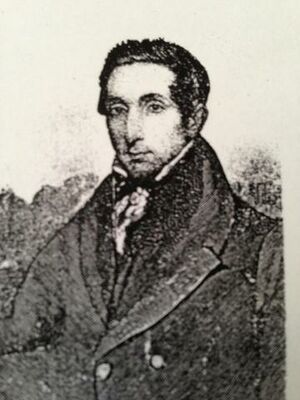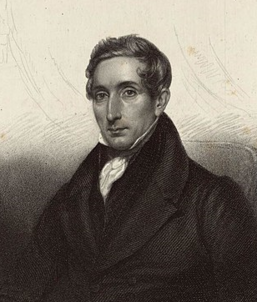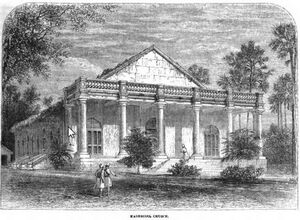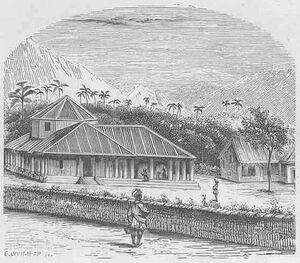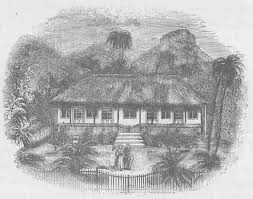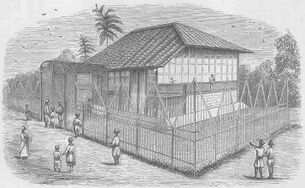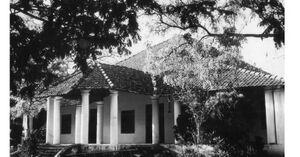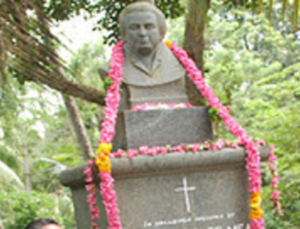Charles Mead
இந்தப் பக்கத்தை தமிழில் வாசிக்க: சார்ல்ஸ் மீட்
Charles Mead (October 2, 1792 - January 10, 1873) was an LMS missionary and educator. Apart from promoting Christianity in South Travancore, he laid the foundations for Western education in the region. The work he did on behalf of the London Missionary Society in the city of Nagercoil, Tamil Nadu, India (then part of the Kingdom of Travancore) earned him the sobriquet, the Sculptor of Nagercoil.
Early Life and Education
Charles Mead was born to Anglican parents on October 2, 1792, in Bristol in the county of Gloucester, England. His maternal uncle, Rev. John Hunt, was a pastor in Wakefield. Mead did his schooling in Gosport Missionary School, Yorkshire. He was ordained on March 6, 1816.
Personal Life
Mead married Anne Hunt, the daughter of his uncle John Hunt. Having already taken ill when they arrived at Chennai (formerly, Madras), Anne Hunt died after giving birth to a son at Prince of Wales Island harbour. Charles Mead proceeded to Colachel (in present day Kanyakumari district) with his son, John Hunt.
Mead then married Johanna Coelestina, the first female missionary to serve in South Travancore. She was the daughter of Rev. Horst who served as a missionary in Thanjavur. Johanna Mead contributed immensely to women's education and to the development of handicraft as a business amongst women in Nagercoil. Johanna died on February 6, 1848 in Neyyoor due to liver disease. She was forty five.
In 1852, five years after Johanna’s death, Mead married Lois Biddulph, the daughter of his assistant, Devavaram Biddulph. He was 60. The couple had four children. European missionaries disapproved of his marriage to an Indian woman. Indian Christians too who registered their protest in various churches. Therefore, in April 1852, Mead resigned from his duties at the Missionary Society. The then Resident of Travancore granted him a government job and so Mead relocated to Thiruvananthapuram. He was appointed as a senior officer in the government's printing press and as an inspector for English schools. He was a minister at an English church that was part of the Christian Mission Society (C.M.S.) as well. The campus where he stayed in Thiruvananthapuram is now known as Mead's Compound.
Mead was father to fifteen children from his three wives. Joanna Carlotta, a daughter he had with his third wife, married the renowned Christian historian, C.M. Agur, the author of the classic book, ’Church History of Travancore'.
Anne Hunt
- John Hunt Mead
Johanna Mead
- Theodore Mead
- Joseph Mead
- Sophia Stemnett Mead
- Florence Mead
- Rachel Mead
- Ann Cammerer Mead
- Christopher Cornelius Mead
- Nathaniel Mead
- Eusebius Mead
- James Mead
Lois Biddulph
- Mary Ann Mead
- Joanna Carlotta Agur
- John James Mead
- Celestina Florence Kohlhoff
Religious Work
Mead, who joined the London Missionary Society, was nominated to succeed Rev. Ringeltaube in Nagercoil, after his death. He left England, along with his wife, on April 20, 1816 and landed in Chennai on August 28, 1816. Rev. Richard Knill accompanied him.
At the Madras Presidency, Mead stayed with the first English missionary in Madras, Rev. Loveless and learnt the Tamil language. His wife was undergoing medical treatment at that time. He informed Col. Munro, the then Resident of Travancore of their impending arrival and left for Travancore on September 9, 1817, along with his wife. He reached Colachel on January 17, 1818 without his wife, who died enroute.
In Colachel, Mead was welcomed by the evangelist Vedamanikkam and other preachers, who by then had been converted by Rev. Ringeltaube. They escorted him to Myladi, where Mead witnessed first hand, the well-oiled missionary activities started by Ringeltaube. Mead stayed with Ringeltaube in a thatched hut, the latter's home. Mead was later allotted a government bungalow by Colonel Munro.
In due course, Mead relocated the headquarters of the Mission from Myladi to Nagercoil. The office of Colonel Munro in Nagercoil became his residence and the Church, his headquarters. In addition, Maharani Gowri Parvathi Bayi granted him the lands on which the Nagercoil Kasba Diocese Church and the printing press of Scott Christian College were located, as well as those surrounding these establishments.
In April 1818, the Maharani appointed Mead as the District Judge of Nagercoil. He also received a grant of five thousand rupees from her, towards the purchase of land and construction of a church in Nagercoil. Mead planned to build a large church with a capacity to seat at least three thousand people. On January 1, 1819, Rev. Knill laid the foundation for a church, 140 feet by 70 feet in area. The construction of the church was completed with monetary aid from Colonel Munro and the government. It later came to be known as C.S.I. Home Church.
While serving as a government officer, Mead built a well-protected granary at Myladi, large enough to hold 1500 kottais of paddy. The upper storey of the granary was equipped with guest rooms for European visitors. Guards for the granary were chosen from Vedamanikkam's family.
Mead's efforts increased the number of churches from seven at the end of Ringaltaube's tenure to fifteen by the year 1819. He divided the South Travancore Mission into five districts, viz., Nagercoil, Neyyoor, Parassala, Thiruvananthapuram, Attingal, and Kollam and laid down administrative guidelines to aid rapid growth.
Contribution to Education
Mead started a seminary in Nagercoil in October 1819, where the languages of English, Tamil, and Malayalam were taught in addition to theology. In 1820, he also started an English school near the seminary. Johanna Mead, his wife, started a girls school and a handicrafts training institute in the vicinity. Mead dreamt of the seminary becoming a college someday, and so it did. In 1893, the seminary became the Scott Christian College. In 1820, Mead started an English school that aslo taught non-Christians students. The Neyyoor branch of the Mission started a similar school. By 1927, the London Missionary Society had opened 47 schools in South Travancore.
In 1820, while on a trip to Thanjavur he came across a printing press. He bought it and promptly started Travancore’s first printing press in the city of Nagercoil. He used it to disseminate the Mission's news. Paper was shipped from Britain as a donation, since paper was not produced in Travancore. The printing press was called Travancore Mission Press.
Mead left South Travancore for Kumbakonam in 1825. He stayed there for almost two years and founded a new base for the Mission, there. He returned to Nagercoil in 1827 after having mobilised enough donations for the construction of the city's church. In 1828, he was transferred to the western districts, with its headquarters in Neyyoor. As there were no suitable residence in Neyyoor on his arrival, he stayed with his family in a small house beside the Mandaikadu beach, until a bungalow was built for him.
In December 1836, Mead left for England on a vacation, returning to Travancore in March 1838 after recuperating. He continued his religious and educational service in Thiruvananthapuram this time. In the last phase of his life, Mead turned full-time educator and ran both schools and presses in Thiruvananthapuram.
Upper Cloth Revolt
In the years 1828 and 1829, there were widespread opposition against women from the oppressed castes covering their upper body, a practice exclusive to high-caste women until then. Revolt broke out in and around the taluks of Kalkulam, Vilavancode, Agastheeswaram, and Eraniel. The upper castes' displeasure against religious conversion, also sowed the seeds for such an opposition. Mead met with the Resident and arranged to put an end to the revolt. On January 3, 1829, a mob laid siege to his house at Mandaikadu with an aim to assassinate Meade. Mead was rescued with the help of the army stationed at the Udayagiri fort. See also Upper-body Cloth Revolt.
Death
Charles Mead died on January 10, 1873 at the age of 81. He was buried in the compound of the C.M.S. church in Thiruvananthapuram.
Memorials
- A street in Nagercoil is named in the memory of Charles Mead.
- C.S.I. Church has named the Mandaikadu diocese as the Mead Memorial Church.
Links
- Charles Mead
- Faith and Family: Robert Caldwell and his Missionary Dynasty
- Sirakugal: Rev.Charles Mead- Father of the South Travancore Mission
- Rev Charles Mead South Travancore Mission, biography, life, ministry
✅Finalised Page
